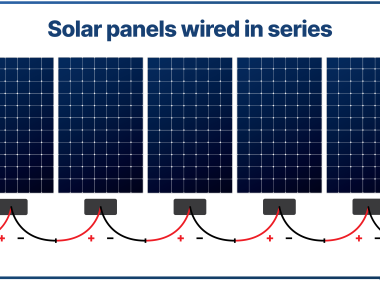What Is the Life Expectancy of a Solar Battery?
The first question you’re likely to ask yourself is, “How long do solar batteries last?” You don’t want a battery that needs to be replaced before it’s provided a return on investment!
The life expectancy of a solar battery, also known as a solar energy storage battery or solar storage system, depends on various factors including the type of battery, its usage patterns, maintenance, and environmental conditions.
In this article, we’ll take a deep dive into solar battery lifespan and all of the factors that play a vital role in the lifespan of solar battery
The lifespan of solar batteries can vary between five and sisteen years. Of course, this is a very large range, but you have more control over it than you might think.
Several factors play into solar battery lifespan, including what type of solar battery you purchase, how often you use the solar battery, the temperature of the battery or surrounding area, and how well the battery is maintained.
To get the most value out of your solar battery, make sure to learn how various factors affect your battery.
Solar Battery Type
One of the most important and fundamental decisions you can make about the solar battery you purchase is the solar battery type. Depending on the type of solar battery you select, the battery may last longer or shorter in relation to its application. Knowing the pros and cons of each type of solar battery will inform you which applications you should consider them for.
We will be looking at two primary types: lead-acid batteries and lithium-ion batteries. While lithium-ion batteries tend to have many advantages over lead-acid batteries, it’s important to understand how you can use them in order to get the best value.
Lead-Acid Batteries
Lead-acid batteries; Are generally the least expensive of the two types and the least expensive kind of solar battery overall. The savings on upfront cost make lead-acid batteries an attractive option where budget is a concern. However, lead-acid batteries do come with a few significant limitations.
Lead-acid batteries: These are one of the oldest and most common types of batteries used in solar energy systems. With proper maintenance, lead-acid batteries typically last around 5 to 10 years. However, their lifespan can be significantly reduced if they are frequently deeply discharged or exposed to extreme temperatures.
Lithium-Ion Batteries
Lithium-ion batteries are the most trusted for just about any solar system application. They offer a compact, lightweight solution with a higher depth of discharge and superior solar battery lifespan. Adding to their long list of benefits are higher capacities and better efficiency.
All in all, you tend to get more out of lithium-ion batteries versus other solar batteries.
Many lithium-ion batteries will last two to three years, or 300 to 500 cycles, but some can go further. Keep in mind that lithium-ion batteries are best for solar power systems that are actively used. Each cycle of a lithium-ion battery tends to offer more value than a lead-acid battery cycle due to the lithium-ion battery’s higher efficiency, higher depth of discharge, and higher capacity.
How Often You Use the Batteries
When asking yourself, “How long do solar batteries last,” try not to think in terms of years. The best way to measure the lifespan of solar batteries is in cycles.
A cycle is the amount of time it takes to drain and recharge a battery. Cycles are an important detail because you might not always be using your solar battery, or you might be using it constantly. A measurement in years might not do you much good in either case.
With every cycle spent, your battery gets closer and closer to degrading. While degradation happens slowly over the course of the battery’s life, it gets much faster at the end.
Degradation affects your battery’s ability to hold a charge. With every cycle, your battery will discharge its charge faster and faster. Once degradation becomes significant, the battery won’t hold a charge long enough for it to be useful.
The best way to extend the lifespan of your solar battery is to pay close attention to your manufacturer’s recommended depth of discharge. The depth of discharge is the charge remaining in your battery, measured as a percentage as you might see in a smartphone.
For instance, if your battery’s manufacturer recommends a DoD of around 40%, avoid draining the battery past the 40% mark. If you fully drain your battery every time, you may significantly reduce your battery’s overall lifespan.
Partial-discharge cycles will help give you the best value. By using only 20% or 30% of your battery’s charge at a time, you can significantly improve its cycle life. For best results, avoid charging your battery to 100%.
The frequency with which you can use your solar battery depends on several factors, including its capacity, the amount of solar energy being generated, your energy consumption patterns, and how effectively your battery management system operates. Here are some key points to consider:
Battery Capacity: The capacity of your solar battery is crucial in determining how often you can use it. Larger capacity batteries can store more energy and thus allow for more frequent usage. If you frequently use more energy than your solar panels generate during the day, you’ll rely more heavily on your battery, potentially leading to more frequent charging and discharging cycles.
Solar Energy Generation: The frequency of use of your solar battery is closely tied to the amount of solar energy your panels generate. If your solar panels generate ample energy during the day, you may not need to rely on your battery as often. In contrast, if your solar panels produce less energy or if you have high energy demands, you may need to use your battery more frequently.
Energy Consumption Patterns: Your energy consumption patterns also influence how often you use your solar battery. If you have consistent energy demands throughout the day and night, you may rely on your battery more frequently. On the other hand, if you primarily use energy during daylight hours when your solar panels are producing energy, you may use your battery less often.
Battery Management System: A well-designed battery management system can optimize charging and discharging cycles to maximize the lifespan of your solar battery. This system may incorporate features such as intelligent charge control, depth of discharge management, and temperature regulation to ensure efficient and reliable operation.
Depth of Discharge (DoD): The depth to which you discharge your battery during each cycle can impact its lifespan. Shallower discharges typically result in longer battery life. Therefore, if you aim to prolong the lifespan of your solar battery, you may choose to discharge it less deeply, which could affect how often you use it.
Battery Maintenance
- Before you ask yourself, “how long do solar batteries last,” you should ask yourself if you’re prepared to tackle battery maintenance. Battery maintenance is one of the most critical factors in determining the lifespan of your battery. Without the right level of care, it’s possible to end up with a dud battery in just a few weeks.
Lithium-ion batteries have the most straightforward maintenance. Every so often, take a State of Charge reading. This will inform you whether your battery is holding a charge properly. Afterward, make sure to check your cables and terminals to verify everything is tight and secure. Finally, dust off your battery so it doesn’t generate any extra heat.
Lead-acid batteries are a little more involved, as there are two types of lead-acid batteries to consider. There are sealed lead-acid batteries and flooded lead-acid batteries.
For sealed lead-acid batteries, all you need to do is check the state of charge with a multimeter occasionally. Do this when the battery is under no load. Then, inspect cables and terminals, and tighten any loose connections. Remember to dust the battery.
For flooded lead-acid batteries, you need to check your battery every two to four weeks for best results. Water levels will drop over time, so make sure to refill using distilled water only. Only fill to the max level line.
Using a refractometer, check the state of charge. You want to see if your battery holds a charge after a full charge cycle. Perform a controlled overcharge every one to three months to ensure your cells are charging equally.
Solar Battery Temperature
Like anything using electricity, temperature is a constantly important consideration. Batteries won’t do well in either extreme heat or extreme cold. The best place for a solar battery is in a temperature-controlled space where it won’t be exposed to the elements.
When exposed to high levels of heat, the chemical reactions inside the battery will accelerate. This will decrease its lifespan and increase the rate of wear and tear, leading to more frequent replacements.
Cold, on the other hand, will slow chemical reactions. This causes electrons to slow down and chemical reactions to end sooner, draining the battery much faster than usual and leading to more frequent drain-recharge cycles.
Lead-acid batteries are especially vulnerable to extreme temperatures. For lead-acid batteries, do your best to keep them in environments where the ambient temperature is between 40°F and 80°F.
For lithium-ion batteries, the range is more generous. Keep them in areas between 0°F and 140°F for best results, and do your best to avoid either end of the temperature spectrum.
How Do I Know If My Solar Battery Is Bad?
Over time, the chances increase that you’ll discover your solar battery has gone bad. Before getting rid of it, do a quick visual inspection. Look for broken terminals, leaking, discoloration, cracks, ruptures, bulges, and bumps.
Broken terminals typically indicate a short-circuit has occurred. If your battery has broken terminals, it is in dangerous condition and should be replaced as soon as possible. Bulging or bumps in the casing indicate overcharging. This usually means there is a problem with the charge controller. If you find any cracks or ruptures, it means the battery has significantly degraded.












